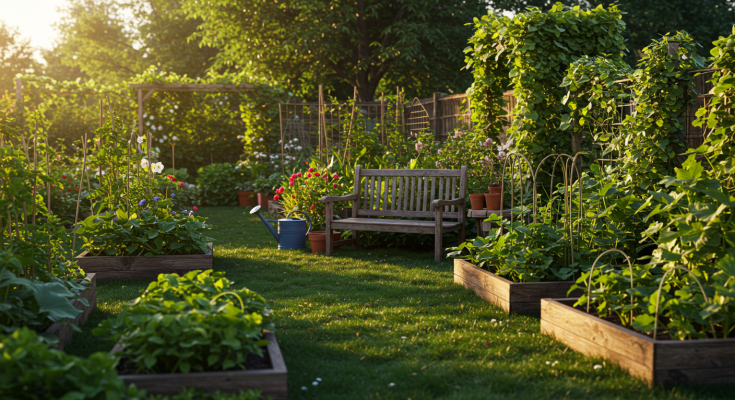Whether you’re a beginner with a few houseplants or a seasoned gardener with raised beds full of vegetables, one thing is universal: every plant has the potential to thrive — if you give it the right care. This comprehensive guide will walk you through everything you need to know to grow lush, healthy plants that burst with life.
☀️ 1. Understand Your Plant’s Light Needs
Light is one of the most essential factors for plant growth. But not all plants need the same amount of sun.
Types of Light Exposure:
-
Full Sun (6+ hours): Ideal for tomatoes, peppers, sunflowers, lavender, and succulents.
-
Partial Sun/Part Shade (3–6 hours): Good for leafy greens like lettuce and herbs like parsley.
-
Full Shade (less than 3 hours): Suitable for hostas, ferns, and some indoor houseplants.
Tip:
If your plant isn’t thriving, check its light requirements and adjust its location. Use grow lights indoors if sunlight is limited.
💧 2. Master the Art of Watering
Overwatering and underwatering are two of the most common reasons plants fail. The key is consistency and observation.
Smart Watering Tips:
-
Stick your finger into the soil about an inch deep; if it’s dry, it’s time to water.
-
Water early in the morning to reduce evaporation and prevent mildew.
-
Water the base of the plant, not the leaves, to avoid fungal diseases.
-
For containers, make sure they have proper drainage to avoid root rot.
Bonus Tip:
Mulch around your plants to retain moisture and reduce the need for frequent watering.
🌱 3. Feed Your Soil, Not Just Your Plants
Plants draw their nutrients from the soil, so soil health is critical. Think of it as feeding the roots from the ground up.
Ways to Improve Soil:
-
Compost: Add decomposed organic matter to enrich your soil naturally.
-
Organic Fertilizers: Use fish emulsion, bone meal, or seaweed extract for natural nourishment.
-
Worm Castings: These are rich in nutrients and help improve soil texture.
Avoid synthetic fertilizers that give a quick boost but degrade the soil over time. Healthy soil means stronger, more resilient plants.
✂️ 4. Prune, Deadhead, and Pinch Back
Regular maintenance helps plants channel energy into new growth rather than struggling with old or dead parts.
What to Do:
-
Deadheading: Remove faded flowers to encourage more blooms.
-
Pruning: Trim leggy or overgrown branches to shape the plant and increase airflow.
-
Pinching Back: Gently remove the tips of stems to encourage bushier growth.
Pruning also improves air circulation, which helps prevent diseases.
🐛 5. Prevent and Control Pests Naturally
Pests can quickly destroy a thriving garden if not addressed early. However, harsh chemicals can do more harm than good.
Natural Pest Solutions:
-
Neem Oil: A safe, organic spray that repels many garden pests.
-
Insecticidal Soap: Effective against soft-bodied insects like aphids.
-
Companion Planting: Grow basil near tomatoes or marigolds around veggies to deter pests naturally.
-
Introduce Beneficial Insects: Ladybugs and lacewings feed on common pests.
Check your plants weekly for signs of damage or eggs, and act quickly.
🪴 6. Choose the Right Containers and Spacing
If you’re gardening in pots or a small space, the type of container matters.
Tips:
-
Use pots with drainage holes.
-
Choose breathable materials like terracotta.
-
Don’t overcrowd plants—airflow is essential for preventing mold and disease.
Even in small spaces, vertical gardening or raised beds can give your plants more room to grow.
🌼 7. Use Companion Planting to Your Advantage
Nature works in harmony. Some plants grow better together and even help each other thrive.
Classic Companion Combinations:
-
Tomatoes + Basil: Basil repels pests and enhances tomato flavor.
-
Carrots + Onions: Onions deter carrot flies.
-
Corn + Beans + Squash: The “Three Sisters” support each other nutritionally and structurally.
Avoid planting crops that compete for nutrients in the same space.
🌦 8. Protect Plants From the Elements
Weather extremes can damage even the healthiest plants. Keep your garden safe with a few simple steps:
-
Use row covers during cold snaps or pest season.
-
Provide shade in hot summers with cloth or netting.
-
Stake or cage plants like tomatoes to support heavy growth.
Windbreaks and mulch can also help maintain a stable environment.
📆 9. Observe, Learn, and Adjust
The most successful gardeners are good observers. Spend a few minutes each day walking through your garden or checking your indoor plants.
Watch for:
-
Yellowing leaves (possible nutrient issues)
-
Drooping stems (likely watering problem)
-
Spots or holes (pests or disease)
Document your planting dates, weather conditions, and harvests. Learning from each season helps you improve year after year.
🧠 Final Thoughts: Grow with Confidence
You don’t need a green thumb to grow thriving plants—you just need the right information, consistency, and a little patience. Every plant is a living thing with its own needs. When you learn to listen to them, they’ll reward you with beauty, flavor, and joy.
Ready to grow your best garden yet? Start today—because thriving plants start with thriving habits. 🌿🌸🌱

